Development

Atmospheric Adjustments | Update 27.2
Aug 2nd
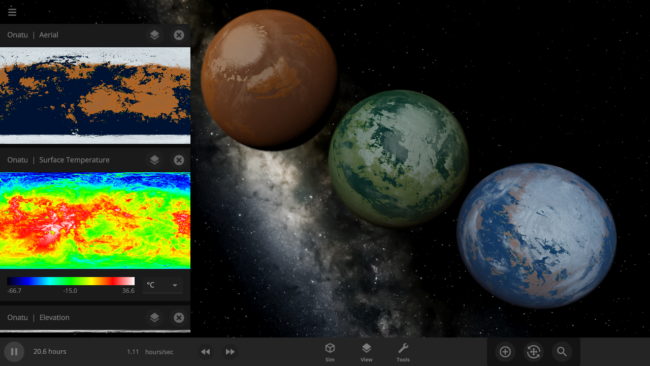
Run Steam to download Update 27.2, or buy Universe Sandbox via our website or the Steam Store.
Update 27.2
You can now change specific simulation interactions, like gravity and collisions, on a per-object basis! This minor update also includes simulated atmosphere opacity (a measure of how hard it is to see through the atmosphere), bug fixes, and more.
Individual Object Simulation Manipulation
The ability to turn off specific simulation interactions on a per-object basis has been added to all objects in Properties > Overview. We plan to add to this over time, and we hope you enjoy creating all kinds of crazy scenarios with these options as much as we do!
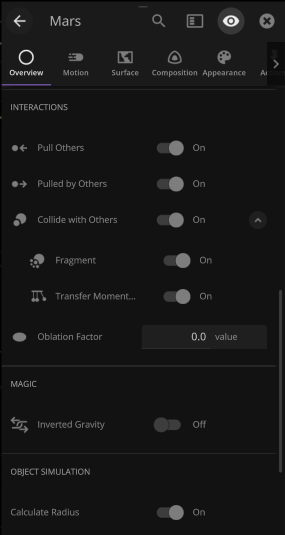
Opaque Atmospheres
Atmosphere Opacity is now simulated based on an object’s properties, like Radius and Atmosphere Mass. Learn more about this new feature in our Atmospheres guide under Guides > Science > Atmospheres.
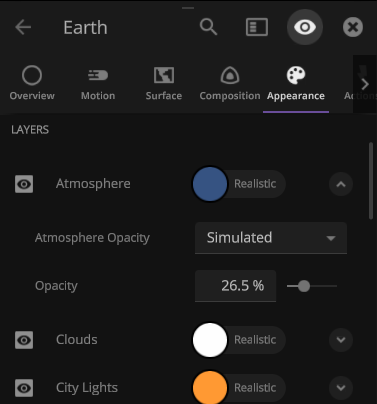
More Highlights
- Polar ice caps on random rocky planets are now informed by the water depth around the poles and are no longer circles
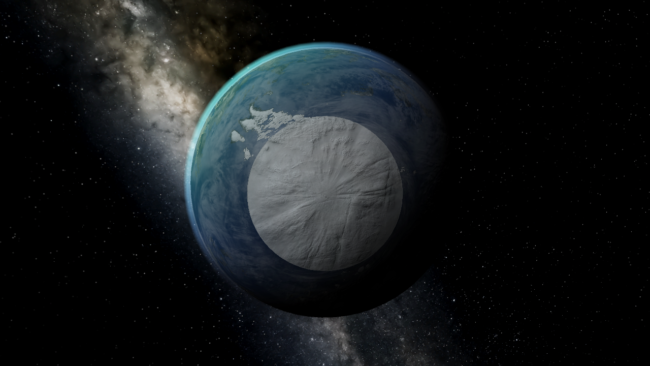
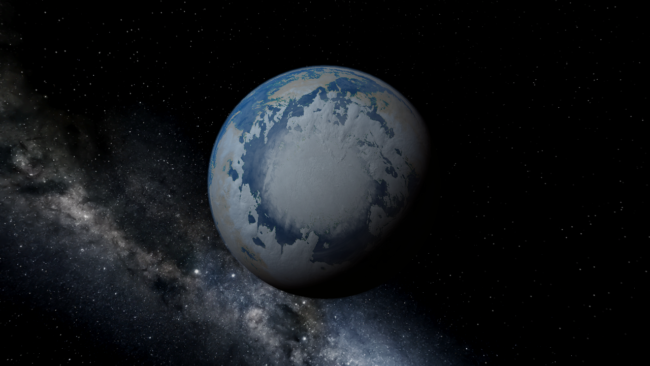
- Opening multiple surface data views no longer causes a noticeable reduction in performance
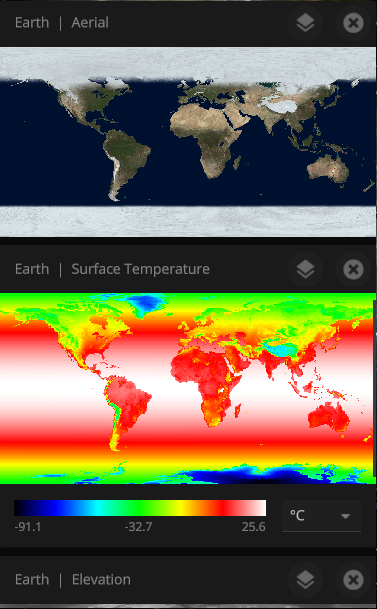
Check out the full list of What’s New in Update 27.2
Please report any issues on our Steam forum, on Discord, or in-game via Home > Send Feedback.

Clouds in Motion | Update 27.1
Jun 21st
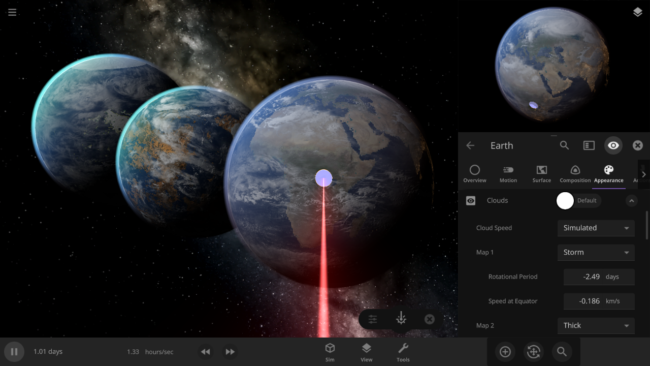
Run Steam to download Update 27.1, or buy Universe Sandbox via our website or the Steam Store.
Update 27.1
Cloud speed is now simulated based on an object’s temperature and rotation speed. Surface simulation performance improvements, an Appearance interface redesign, adjustable planetary rim lighting, and more round out this minor update.
The feature image shows a laser heating up the Earth to speed up the cloud rotation and our new atmosphere opacity property.
Simulated Cloud Speed
Cloud speed is now simulated based on an object’s temperature and rotation speed as part of our continued incremental improvements of clouds. Check out our new Clouds guide for a tour through our entire cloud system: Guides > Science > Clouds.
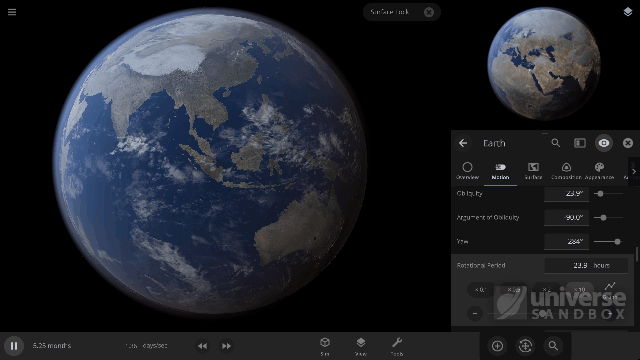
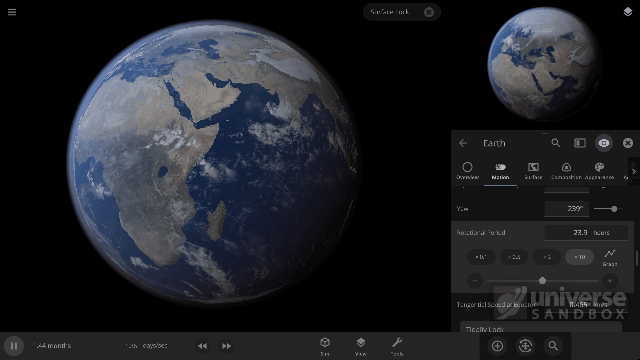
Easier Appearance Editing
As part of our continued user interface improvements, the Properties > Appearance tab has been redesigned to combine color customization with visibility and other options to make changing the appearance of an object even easier.
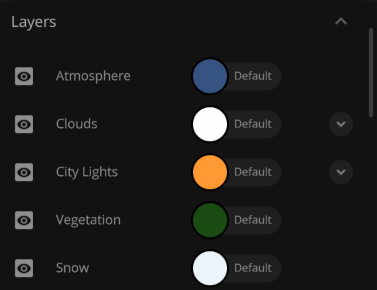
More Highlights
- Surface Simulation has been improved to update only objects that are changing each frame, improving performance for simulations with many objects
- Created simulation of NASA’s Juno spacecraft flyby of Ganymede in June 2021: Open > Historical > Juno Flyby of Ganymede in 2021
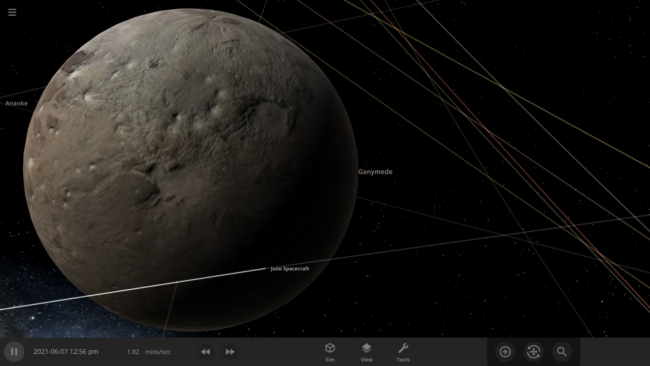
- Star glows correctly fade as you get farther away from them when Object Visibility is set to Realistic again
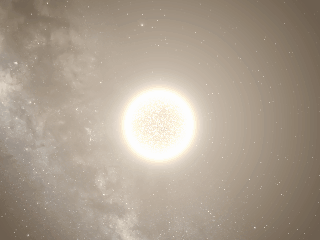
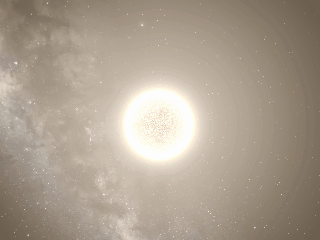
- Added Atmosphere Density and Speed of Sound Properties to Properties > Surface > Atmosphere
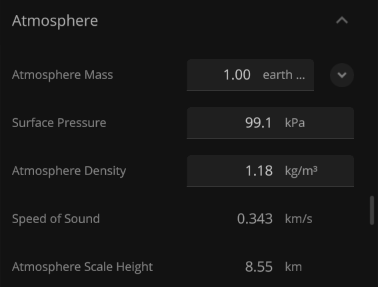
- Rim Lighting can now be adjusted under View > Object Visibility > Rim Lighting
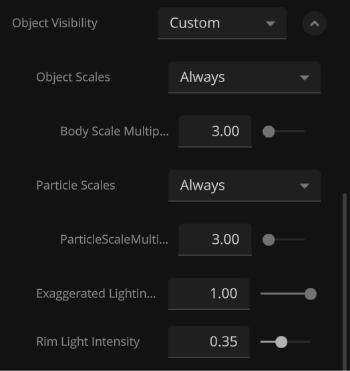
Check out the full list of What’s New in Update 27.1
You can also check out our 2021 Roadmap to learn more about what we’re currently working on!
Please report any issues on our Steam forum, on Discord, or in-game via Home > Send Feedback.

Universe Sandbox Roadmap: 2021.5 & Beyond
Jun 16th
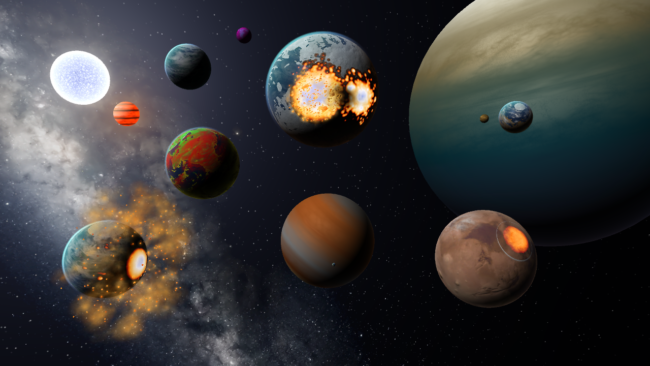
Last year we worked hard to make Universe Sandbox even better, and we’ve continued that work into this year with two updates already. We wanted to share some of the exciting plans we have for upcoming features including terrain manipulation, an expanded materials system, and more, that we have for the rest of the year (and a bit beyond).
What did we do in 2020?
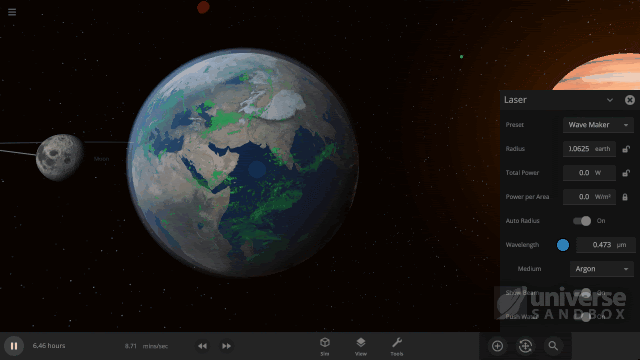
In 2020 we had two major updates and a few minor updates as well.
- I Like My Heat Tidal | Update 25
- Rewrote the tidal heating model and temperature calculations
- Major graphics performance improvements which allowed us to improve surface simulation
- Light It Up | Update 25.1
- Added randomizable city lights to all planets
- Improved how multiple light sources interact, particularly with atmospheres
- Even More Colors in Space | Update 25.2
- Even more custom color options for clouds, city lights, asteroids, and galaxies
- Improved energy calculations even more with laser, explosions, and impacts
- Reimagined Experience – Unified VR & Desktop | Update 26
- We brought the full desktop experience into VR
- Reimagined user interface with a customizable bottom bar
- Better looking collision fragments, rocky planets, and liquid water
- Star Fusion & the Brown Dwarves | Update 26.1
- Smoother simulated transitions between gas giant, brown dwarf, and full fledged star
- More customizable colors and laser improvements, including the “Wave Maker” laser
- Ending 2020 with a Bang | Update 26.2
- Objects retain lasting surface damage with craters and scorched areas
- More realistic explosions with better simulated gas particles
View our “What’s New” for a chronological list of changes.
What have we already done in 2021?
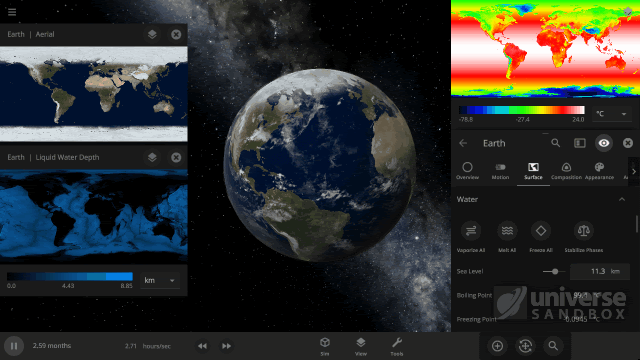
This year has already seen two notable updates that have included many fixes to our core simulation, a few new features, and improvements to the Universe Sandbox experience.
- Splish, Splash, Filling a Bath | Update 26.3
- Water fills from lowest points and flows to lowest points
- Smoother, better performing, and explodi-er collisions
- Fast & Flurrious | Update 27
- More realistic snow simulation and better looking random rocky planets
- Added a separate elevation adjusted surface temperature map
- New Render Scale settings to improve performance for non-gaming hardware
New team members
Brent was hired in March as our new Science Writer & Community Advocate. Brent has a PhD in Physics and will be writing about all of the awesome science and simulations that Universe Sandbox can do (including writing this post – Hi Everybody 😃 ).
We also recently hired Brian as our new User Interface Engineer. Brian joins us after working as a frontend web engineer, and is excited to help make Universe Sandbox the best possible experience for exploring space and science. He’ll be implementing some of the many, many user interface designs we’ve been working on.
What’re we currently working on?
You’ve seen some of what we’ve been up to this year from the updates we’ve put out already, but there’s still a lot of new features in development. While we would love to get all of these new features and improvements out by the end of the year, there may be new priorities or unexpected difficulties that pop up, which make it hard to predict exactly when we will have these features ready.
Surface Grids & Planet Appearances
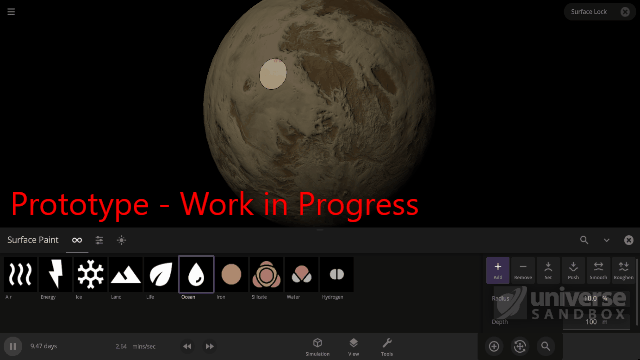
The simulation of temperature, ice, water, vapor, and other properties across the surface of an object, a feature we call Surface Grids, has become a fundamental part of Universe Sandbox. Read more about Surface Grids in our DevLog and ScienceLog series. Yet even with all of the improvements we made to them last year, there is still so much that can be done.
- Planet Surface Editing
- Last year we did a bit of work designing and determining the best way to add tools that will allow you to directly edit the surface properties of an object, and we’re hoping to implement those tools this year.
- You’ll be able to change your planet’s elevation, water level, temperature, and more with single point precision on the surface grid.
- Improved Atmosphere Simulation
- With many improvements in performance in Update 26.3, we are looking into extending the atmosphere of planets into the surface grids simulation.
- Better simulated atmospheres will allow for more realistic climate and cloud simulation.
- Fiery Collisions
- We plan to build upon the collision improvements introduced in Update 26.3 with more realistic post-impact shockwaves, fragmentation, and grazing impacts.
Enhanced User Interface
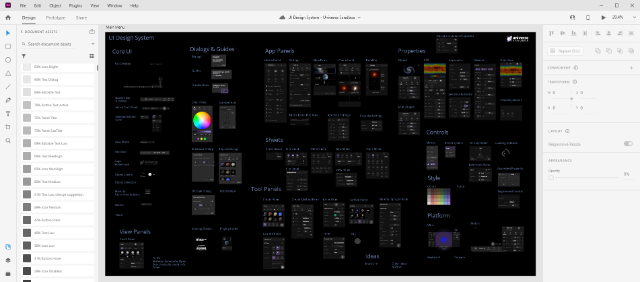
Our goal for each update to Universe Sandbox is to improve your experience. This might involve updating our user interface, improving our guides for new users, increasing performance, and other small tweaks.
- Towards a Forward-Thinking User Interface
- We’ve taken a responsive design approach that lets the interface work universality across desktop, mobile, VR, and future-gamepad support in mind.
- We already redesigned the Add panel in Update 27 and unified the styling in preparation for future tools and features, like the surface enhancement tools we mentioned above.
- The Most Enjoyable Experience
- In addition to guide rails, which help walk users through our tutorials, that were added in Update 27, we want to update and add more guides and science simulations for new and old users alike.
…and Beyond?
In addition to all of these plans, we also have some longer-term goals, and though many of these may not happen for a while, we wanted to share with you.
Multiple & Mixed Materials
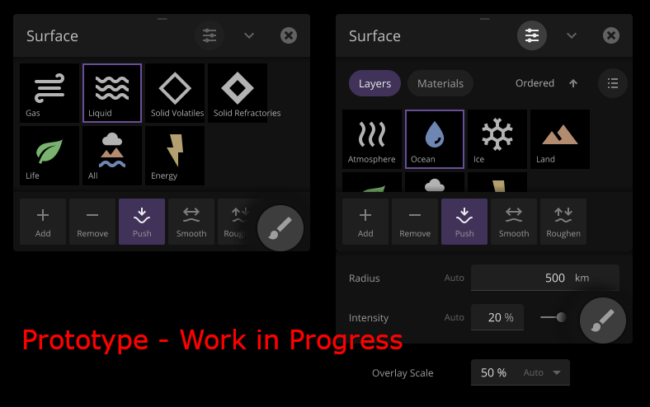
We want to give you access to more basic materials, like methane, CO2 (carbon dioxide) and O2 (oxygen), to our current system. Not only will a more robust material system allow you to further customize your planets, moons, and asteroids, but it will also make future features, like Life Simulation and realistic atmosphere simulation, possible.
- A Material World
- More materials will allow for more planet customization and allow more versatility in terraforming planets. They will also allow you to customize your planet’s atmosphere — will it be suitable for life, or mostly composed of methane like Titan?
- Multiple materials will be critical for developing life simulation in the future. Life is made up of complex materials after all.
- Unified Materials System
- Our goal is to track all the different materials, and the state that they’re in, in each point in a surface grid on planet surfaces.
- Keeping track of all of these materials and their properties will allow for more realistic simulation calculations in general, like the phase state (solid, liquid, gas) changes for all of our new materials.
Rigid Body Physics
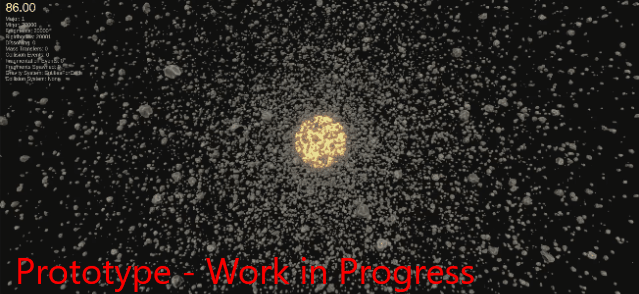
Currently our physics engine isn’t optimized for rigid body physics required for proper human scale (like dice and spacecraft) object interactions. We’re working to change that and have been researching different methods of implementing a whole new suite of physics into Universe Sandbox.
- DOTS-based Unity Physics
- Unity has introduced a promising new physics engine that we’ve been spending time researching. Based on the Unity DOTS (Data Oriented Technology Stack) framework, the new Unity Physics engine promises significantly better performance.
- This DOTS-based Unity Physics would not only enhance our rigid body physics, but would also be used to improve the performance of our gravity simulation.
- To Infinity and Beyond
- Much like Surface Grids, rigid body physics lays the foundation for many simulation features to come, such as spacecraft, thrusters, and megastructures.
- Having more bodies that follow these new physics will also allow you to better simulate how larger bodies form as smaller objects clump together. Make planets out of asteroids, or pigeons, it’s up to you.
Mobile
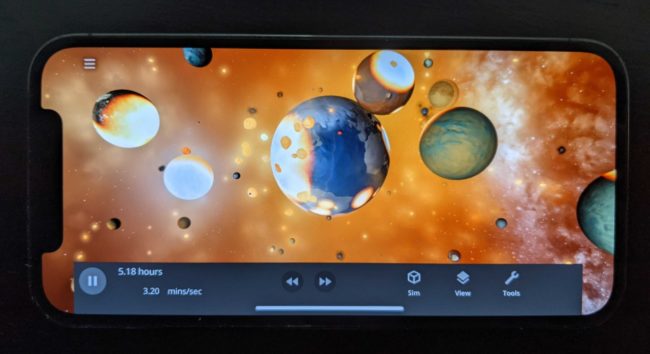
We’re still actively working on a mobile release for both iOS and Android, though there’s still many design questions to be answered.
- The Full Experience on Mobile
- When we bring Universe Sandbox to mobile, we plan to bring the full desktop version to mobile so you’ll have access to all the same features, just in your pocket!
- A smaller screen means our user interface will need to be even more innovative, and we’re working hard to make sure that the mobile experience is just as fun to play as it is on a desktop.
And More
There’s no shortage of additions and improvements to be made when you’re simulating the Universe! We’re also thinking about future features like Lagrange points, atmospheric scattering, and life simulation, and we’re excited to share them all with you!
Hiring
We’re currently hiring another Physics Engineer, join us!
Answering Some of Your Questions (Addendum)
We’re really glad that you all enjoyed reading our Roadmap. You asked a lot of good questions and we wanted to answer some of them here:
1. Will you be able to export (and import) height maps for celestial objects?
We plan to support importing and exporting of surface maps, but we don’t yet know when that will happen.
Much of the surface data (like elevation and color) that we use for known solar system objects is based on data available online. You can find similar maps to the ones we use online, like this set of Moon elevation and color maps (though these are not exactly what we use).
2. What materials are you planning on adding?
Development of adding additional materials to the simulation is still in flux. Our goal is to add all the basic materials that are necessary for simulating basic life like carbon dioxide and oxygen, as well as some others like methane and sulfur, which are found in large quantities on other planets and moons in the solar system.
3. Will we be able to make planets out of any materials?
Great question. When we add additional materials to Universe Sandbox, we are planning to make them available as part of an object’s Composition properties, similar to our current system, so you’ll be able to make planets out of any material we add.
4. Will we be able to make megastructures like Death Stars?
We think this would be really fun, and actually have this on our Roadmap already. The general idea would involve a separate system to build megastructures like Dyson Spheres (or even Death Stars). However we still have a lot to do before we start work on that.
5. Are we adding sentient life as part of our life simulation?
That is a cool idea. We’re still a ways away from even the simple life simulation we are hoping to implement though. The first version of life simulation will likely be a surface map, similar to our other surface grid maps, that would show “amount of biomass” or “vegetation,” but we don’t have all of the details worked out yet.
6. Any plans to make the game run in Vulkan?
While we don’t have any plans right now to support Universe Sandbox for Vulcan, an API for graphics rendering and computing (different from what we currently use), on Desktop, that doesn’t mean we won’t look into it in the future.
7. Will we be adding continental drift or volcanoes?
Right now we don’t have any plans to add either of these features, though we have thought about adding very simple volcanoes in the past. There are a lot of improvements and fixes we need to make to the core features before we think about adding in complicated features like that.
8. Is there a way to beta test new features?
Yes! We will occasionally release Community Test builds to get feedback on new features and help us find bugs. We announce when these go live in a post on the Steam Forums and on our Discord server.
9. What devices will Universe Sandbox mobile be available on and will it be free for those who have already bought Universe Sandbox?
Universe Sandbox will be available on both iOS and Android devices. Minimum device requirements have not been finalized yet.
We still do not have a release date or official price for mobile, but we do plan on it being a one-time paid app with no ads or in-app purchases. The desktop and the mobile versions will be sold on separate stores and will be separate purchases. If you want Universe Sandbox on your mobile device you will need to purchase from the mobile store, even if you already own Universe Sandbox on desktop.
10. Are we still working on Smoothed-particle Hydrodynamics (SPH)?
We have shifted our focus on fixing problems and bugs with the fundamental systems and simulation before resuming work on awesome new features like SPH. That said, we still want to do SPH, but are actively working on improvements to the current collision system that we discussed in the Roadmap.
Learn more about SPH in our SPH blog post.
Updated July, 15, 2021

Fast & Flurrious | Update 27
May 3rd
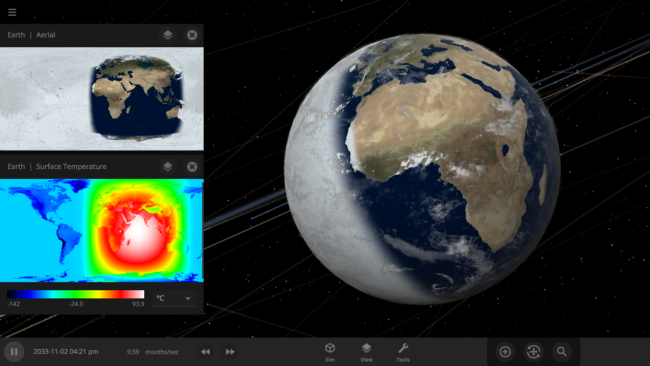
Run Steam to download Update 27, or buy Universe Sandbox via our website or the Steam Store.
Update 27
Snow simulation improvements, more detailed temperature maps, better performance, new cloud visuals, and more are rolled up into Update 27.
The featured image shows what would happen if the Earth was tidally locked, where one side of the planet always faces the Sun.
Superior Snow Simulation
We’re now keeping track of snow so that it falls and melts more realistically. Previously it disappeared immediately if the water vapor got too low. There’s also more accurate snow and ice formations on newly-created random rocky planets!
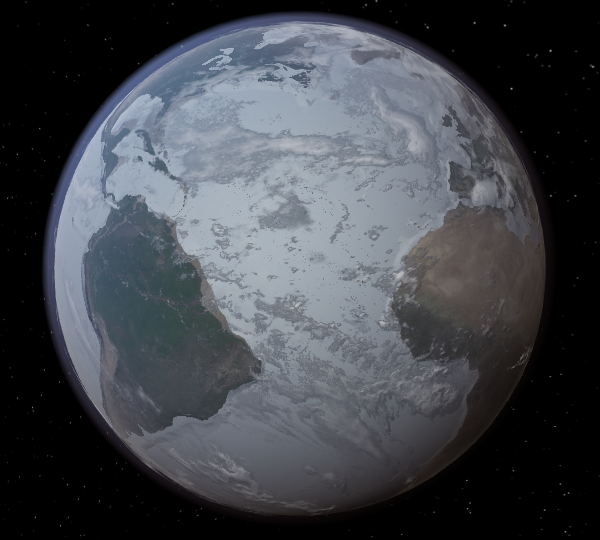
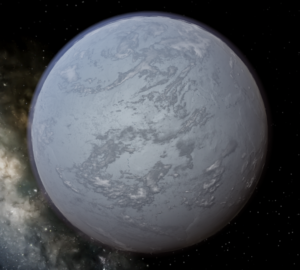
Taking the (Surface) Temperature
Temperature maps have gotten a facelift with the addition of temperature calculations adjusted by elevation. Previously temperature maps were only shown at sea level, even if the elevation data was above sea level.
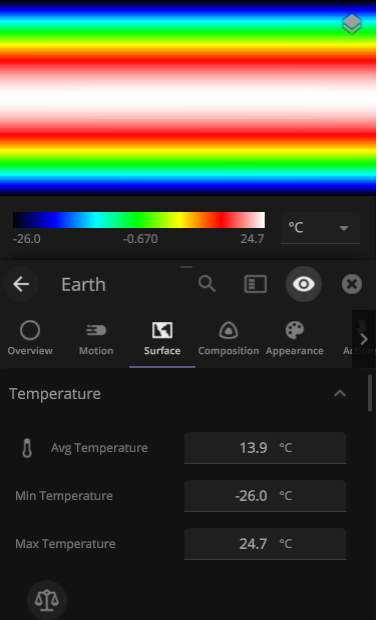
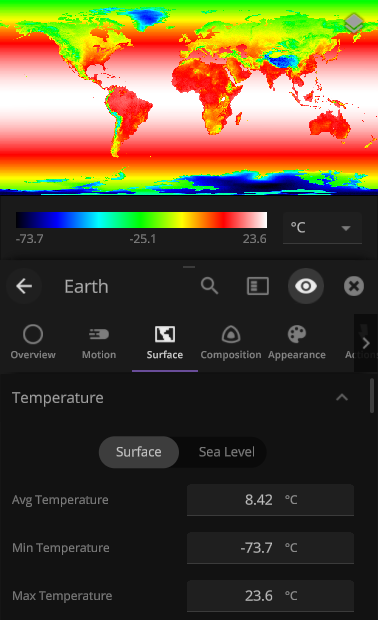
Downscaling to Benefit Non-gaming Hardware
Render Scale has been added as a new graphics setting. This allows you to run the simulation at a lower resolution while keeping the interface looking crisp. The automatic settings have also been updated for improved performance on lower-end hardware.
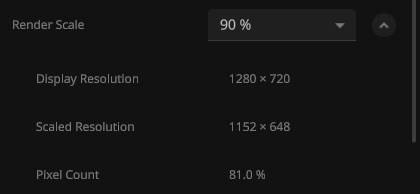
More Highlights
- More customization for cloud visuals on rocky planets, including adjustable coverage and opacity
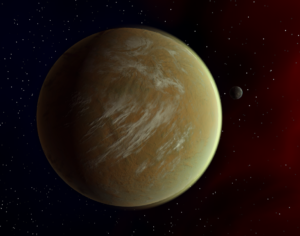
- We’ve added new shapes to our Human Scale Objects
- …and Human Scale Objects can now have custom colors

- View > Object Visibility has been added so that you can see all objects that would normally be impossible to see at realistic scales. You can also really blow them up with advanced settings!
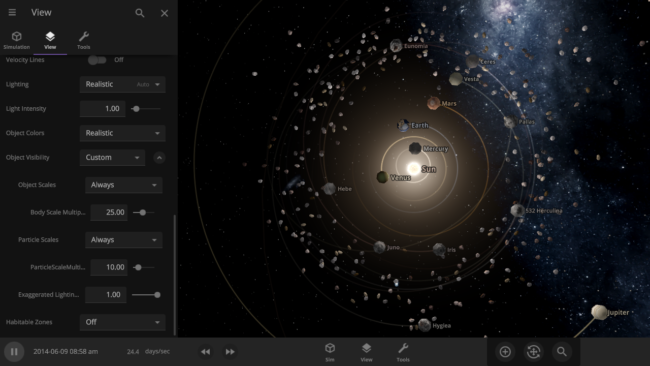
- The Add Panel has been restyled to accommodate smaller screens and to prepare the panel for future plans

- Heating from stars and supernovae is now smoother at high simulation speeds for all spinning objects
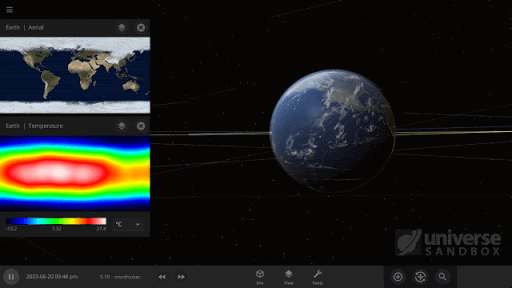
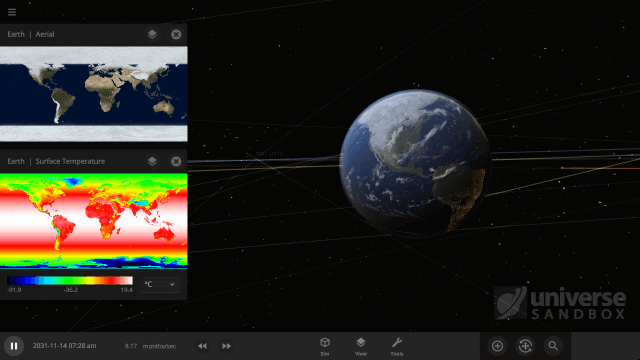
- Our guide system now provides better assistance to new users with Guide Rails
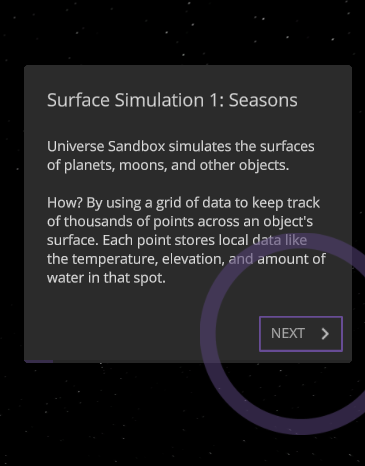
- Curved trails are now more precisely rendered as at high simulation speeds
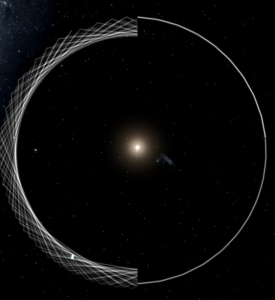
- Dyslexia-friendly font options have been added under Settings > General > Accessibility
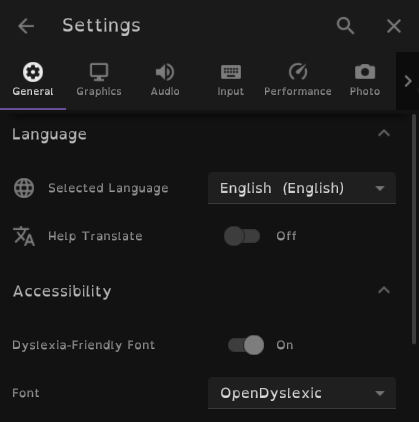
Check out the full list of What’s New in Update 27
Please report any issues on our Steam forum, on Discord, or in-game via Home > Send Feedback.

Splish, Splash, Filling a Bath | Update 26.3
Feb 24th
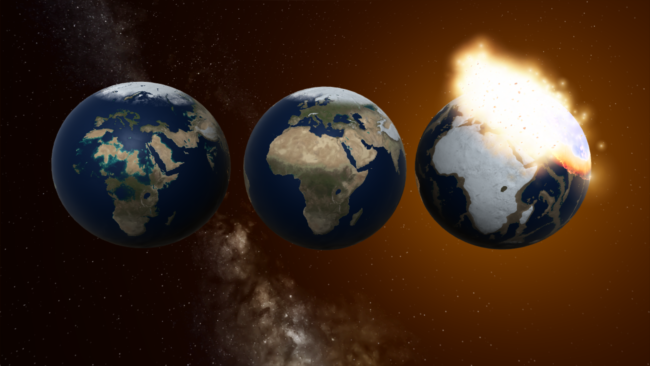
Run Steam to download Update 26.3, or buy Universe Sandbox via our website or the Steam Store.
Update 26.3
Drastically increased collision fragments and framerates, overhauled planetary water distribution, plus dozens of improvements come together in Update 26.3.
Oceans Filling Like a Bathtub
Water fills a tub from its lowest point – why not on a planet? Oceans now start at the lowest elevations and fill valleys like you would a bathtub, creating more realistic-looking continents and oceans. (Previously liquid water would “precipitate” evenly across the surface.)
Buttery Smooth Collisions & Particles Aplenty
Major performance improvements have resulted in epic collisions with double the particles. Fragment generation is substantially more consistent across various simulation speeds. Collisions now perform much more smoothly: in many cases, we’re seeing as much as triple framerate increases.
More Highlights
- Fixed the “annoying bug” that darkened customized planet surfaces
- Ice & Snow, which are simulated separately, now have color options
- Avast, Matey! Change an object’s Sea Level in the properties panel
- Cleaned up the object property panel and added new action buttons
Check out the full list of What’s New in Update 26.3
Please report any issues on our Steam forum, on Discord, or in-game via Home > Send Feedback.

Ending 2020 with a Bang | Update 26.2
Dec 22nd
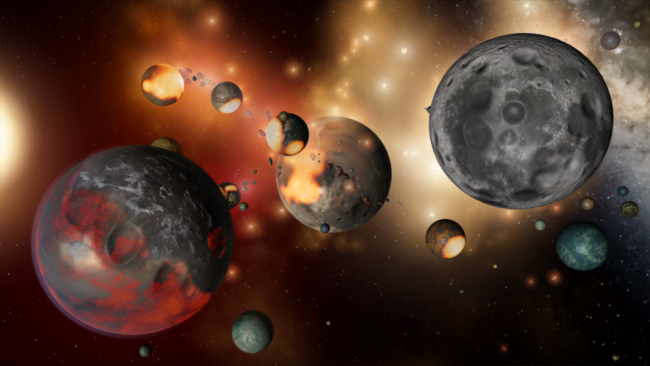
Run Steam to download Update 26.2, or buy Universe Sandbox via our website or the Steam Store.
Update 26.2
Craters from impacts, lasting surface damage, and voluminous explosions all come together in Update 26.2 to close out the year!
Surface Damage & Craters
Molten and heated areas on an object’s surface will appear scorched after cooling, with visible craters in the aftermath of collisions.
Explosions
Rocky objects more accurately vaporize into hot, dense gas clouds when exploded. The simulation of gas particles, which slowly expand over time, is more realistic, and results in dramatic debris clouds after impacts. We’ve also added a Detonation Delay setting to the Explode tool.
Two-Handed Gestures in VR
Move, scale, and rotate the universe using intuitive gestures with both hands and the grip buttons.
Check out the full list of What’s New in Update 26.2
Please report any issues on our Steam forum, on Discord, or in-game via Home > Send Feedback.

Star Fusion & the Brown Dwarfs | Update 26.1
Nov 20th
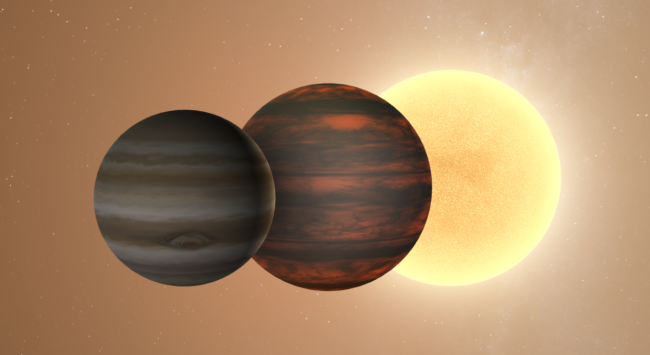
Run Steam to download Update 26.1, or buy Universe Sandbox via our website or the Steam Store.
Brown Dwarf Transitions
We’ve made significant improvements to the simulated transitions of gas giants into brown dwarfs and stars, driven by a newly simulated Fusion Power energy property. Learn more about fusion power and brown dwarfs in our new guide: Guides > Science > Are Gas Giants Failed Stars?
More Color Customization
The color of water on all planets, and the color of vegetation on Earth, are now customizable via Properties > Appearance.
Laser Improvements
Laser presets have been reorganized, and we’ve added a new Push Water setting in the Laser panel. While not entirely realistic, this is a fun way to play with the water simulation on an object’s surface. Try out the “Wave Maker” laser preset to create massive waves in a planet’s oceans..
Please report any issues on our Steam forum, on Discord, or in-game via Home > Send Feedback.

Reimagined Experience – Unified VR & Desktop | Update 26
Oct 29th
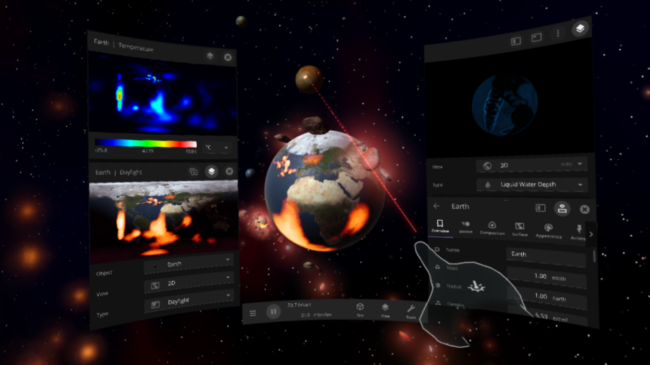
Run Steam to download Update 26, or buy Universe Sandbox via our website or the Steam Store.
Update 26 brings the full Universe Sandbox desktop experience to virtual reality (VR). We redesigned the bottom bar and made visual improvements to collision fragments, rocky planets, and liquid water.
Full Desktop Experience in VR
Universe Sandbox VR now matches the desktop experience and will maintain feature parity moving forward. You can now use virtual hands to manipulate planets, edit properties, or use separate tools in each hand.
Reimagined User Interface
Featuring a customizable bottom bar, our improved user interface makes Universe Sandbox easier to use, more discoverable, and improves support for extra small screens.
Improved Visuals
Collision fragments have new, high-definition graphics and lighting. Elevation maps for rocky planets have more detail. Water graphics now show waves and better light reflection. Asteroids and collision fragments have new highly-detailed dynamic models with better lighting.
This update includes 20+ additions and 50+ fixes and improvements.
Please report any issues on our Steam forum, on Discord, or in-game via Home > Send Feedback.

Even More Color in Space | Update 25.2
Jul 2nd
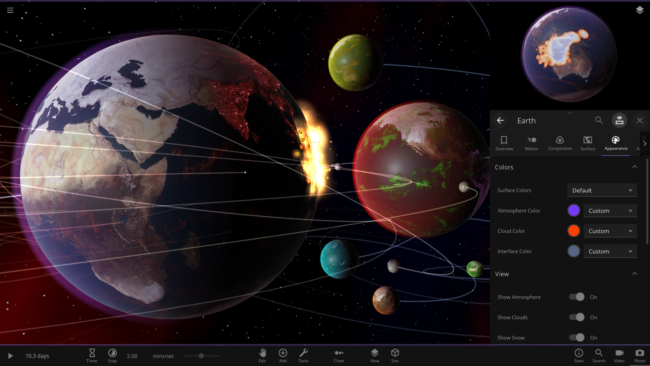
Run Steam to download Update 25.2, or buy Universe Sandbox via our website or the Steam Store, where it’s 33% off until July 9th, 2020.
Update 25.2
Update 25.2 is a minor update that brings even more appearance options, this time to clouds, galaxies, and asteroids. We’ve also improved energy transfer calculations, laser settings, asteroid visuals, and provided various other bug fixes.
Most of the team has been hard at work on our upcoming major updates, but we didn’t want you to wait for these features and bug fixes. Keep an eye out for Update 26 (Coming Soon™) which will bring major improvements to our user interface and VR implementation.
Cloudy with a Chance of Purple
Change the color of clouds, galaxies, city lights, and asteroids. Toggle snow visuals on or off to help distinguish snow from sea ice.
Asteroid Makeover
Asteroids received a complete visual overhaul and color correction.
Improved Energy Simulation
Energy Flow calculations now including lasers, explosions, and impacts. Learn more about Energy Flow from Home > Guides > Science > Energy and Heating in Depth.
Featured Fixes
- Simulations with broken surface data can now be opened
- City Lights no longer appearing incorrectly on some rocky objects
- Black hole radius can now be manually changed as expected
Please report any issues on our Steam forum, on Discord, or in-game via Home > Send Feedback.

Universe Sandbox Roadmap: 2020 & Beyond
Apr 30th
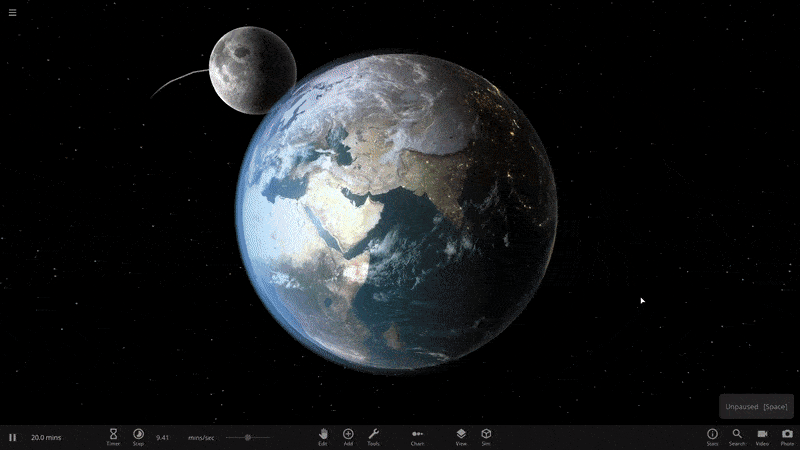
Universe Sandbox has improved significantly since our first Early Access release in 2015. We plan to add features and fix bugs for a long, long time to come (we even removed the “2” from our name for that reason). Here’s a look into what we have planned for 2020 and beyond.
What did we do in 2019?

Last year saw 3 major feature releases (and a handful of minor, but still important, updates):
- Better Galaxies (Update 23)
- More stable and accurate galaxies and better collisions
- New and improved Introduction tutorial for helping new users
- Surface Grids & Lasers (Update 24)
- Surface Grids is a huge, complex feature that simulates the surfaces of planets, moons, and other objects
- Vaporize entire planets with the new Laser tool
- Custom Object Colors (Update 24.1)
- Customize colors for just about every object including planets, moons, stars, and black holes
- Dock graph windows alongside the other panels added with Surface Grids
View our “What’s New” for a chronological list of changes.
What’s the Plan for 2020?
The following list are all things we are working on currently. We’re aiming to deliver on all of this in 2020, but when they’ll be ready is difficult to predict, and priorities can change.
With its ability to simulate localized surface temperatures, water level, vapor content, and more, Surface Grids (Update 24) perfectly sets us up for a multitude of new features. Localized temperatures enabled us to create the mighty Galactic Empire Superlaser, but that’s only scratching the surface…
Surface Grids Improvements

We’ve been saying that Surface Grids is the foundation for many things to come, so it only makes sense that we start the year off by further improving it.
- Improved Temperature & Atmosphere Simulation
- Surface Grids improvements started this year in January (Update 24.1.2), continued with Update 25 (March 2020), and will be a theme all year long
- Update 25 introduced a major rewrite to Tidal Heating and Vapor Flow calculations
- Better Performance & More Power
- Not only have we accomplished localized surface simulations on your everyday computer, but we continue to make performance improvements
- Shader Model 5.0, a graphics card technology, became a requirement in Update 25 because it will give us some legroom for current and future enhancements
- Detailed Surface Manipulation
- We are in the early stages of designing tools that allow for directly manipulating temperature, elevation, water level, vapor, and more on the surfaces of objects
- We plan to add the ability to view and edit the properties of individual surface grid “cells”. Take your planet customization and terraforming to a new heights with a level of precision you never thought possible
Material Composition System
Building off of the localized materials (water, CO2) in Surface Grids, we’re working to rebuild our material composition in a more robust way.
- Better System to Unify Materials
- Every point on the “grid” will better contain a mixture of various materials, in various material states
- Complicated calculations of, for example, when some liquids become heated to a gas, should be handled more efficiently in our new simulation code
- A Universe of Possibility
- Better terraforming, more realistic cloud and climate simulations, tidal waves, easy ways to manipulate the surface topography, and more detail on the surface view could all be the results of this new Material Composition System
- Who knows, maybe our planets could one-day support life?
Full Desktop User Experience in VR
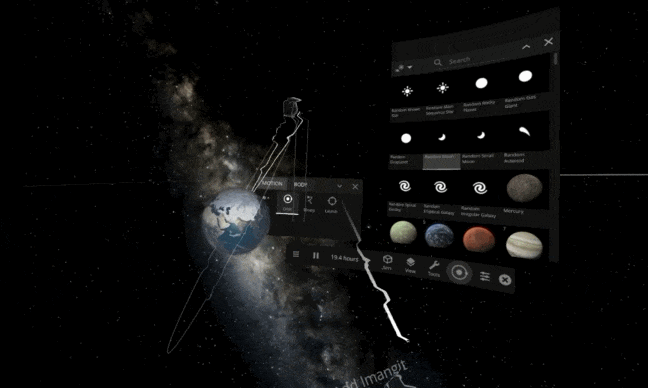
We have embraced a seemingly impossible goal of having a unified Universe Sandbox release no matter how you play. Whether you are on a powerful gaming PC, a laptop, a phone (coming soon), Virtual Reality, Mixed Reality, or a console (maybe soon? who knows!) the experience should be undiluted and awe-inspiring.
- A Magic Leap Forward
- With our recent Magic Leap 1 release, we were able to bring the full Desktop experience to the world of Mixed Reality
- Hard work pays off: the bulk of our Magic Leap 1 development helped unify our Mixed Reality, VR, and Desktop experience into one single vision
- Get Your Hands on it
- Enjoy Universe Sandbox in VR without limitations and with the full Desktop User Interface
- Grab planets with your hands, shoot lasers out of your fingertips, and watch galaxies collide as if you were really there, floating in space (but a bit less cold).
User Interface Improvements
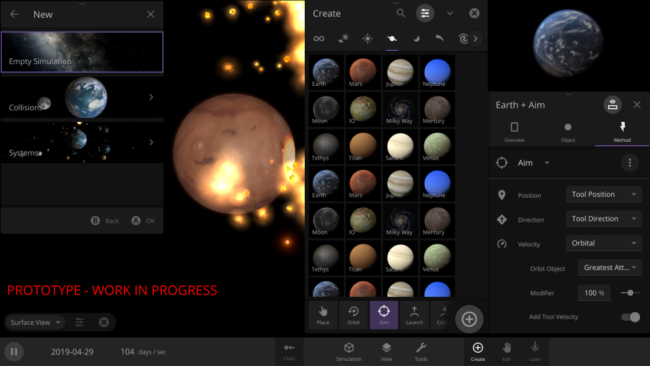
Creating the user interface (UI) for Universe Sandbox is a fun challenge. How do you give someone full control of the universe? As we add features and complexity to the simulation, keeping the UI accessible, discoverable, and easy to use becomes a constant challenge.
Over time, some portions of the interface can start to feel cluttered or outdated and are ready for a redesign. We’ve been working on some of these design changes for a long time, and it’s exciting to move closer to improving everyone’s experience with Universe Sandbox.
- Redesigned Bottom Bar
- Our current bottom bar has been collecting new buttons over the years without a cohesive vision for how it should all work. So we’ve rethought how everything should be organized and how we can make it work on really small screens.
- Improved Add Panel
- Like the Bottom Bar, the Add Panel is due for a makeover. We’re targeting a single shared UI for all platforms (desktop, touch, VR/AR, and consoles), so the new Add Panel is being built with that in mind.
…and beyond?
Mobile
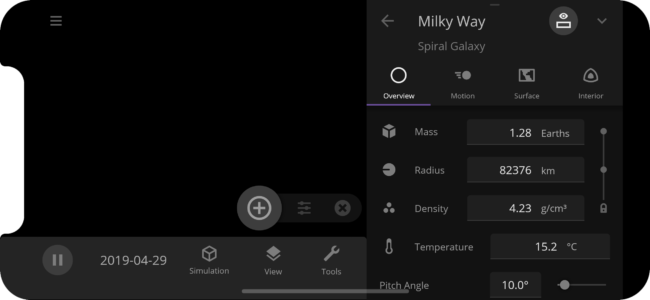
Enjoy Universe Sandbox on your phone or tablet! Sign up to get notified about our mobile version.
- Is that Universe Sandbox in Your Pocket?
- Our mobile version is in development right now for both Android and iOS. It’s no easy feat to simulate the universe on a smartphone, but we’re doing it!
- A Pure, Unadulterated Experience
- Some of the breakthroughs we made with both Surface Grids and Magic Leap have paid off and will allow for the full desktop version on your pocket-sized device
Life Simulation
Create the right conditions for life and watch it grow, or end it all with a major impact.
- Turn a cold, lifeless space rock into a vibrant planet
- Many details are still TBD, keep an eye out for a DevLog when we get started
Fluid Simulation

Smoothed-particle Hydrodynamics (SPH) will help create more detailed, realistic simulations of collisions, fragmentation, and formation of different types of objects. Read more in our SPH Fluid Simulation DevLog.
Experiments with Tools

This is firmly in the realm of experimentation at the moment, but we’re looking at new and interesting ways we can use our tools within a simulation. Driven by a need to automate testing of features, we’re working on ways to programmatically activate tools. By automating and attaching different tools to objects, we discovered that we can enable some pretty fun scenarios. The above clip is what happens when we attached a bunch of lasers to moons and tell it to automatically fire at the nearest object. Awesome stuff, right?
Gamepad Support… and more?
Do you want to sit back on your couch and play Universe Sandbox? So do we! We’ll be experimenting with full gamepad support. Who knows where that leads us, maybe even a console version in the future.
Hiring
We are currently hiring a Spaceship Physics Developer, join us!
